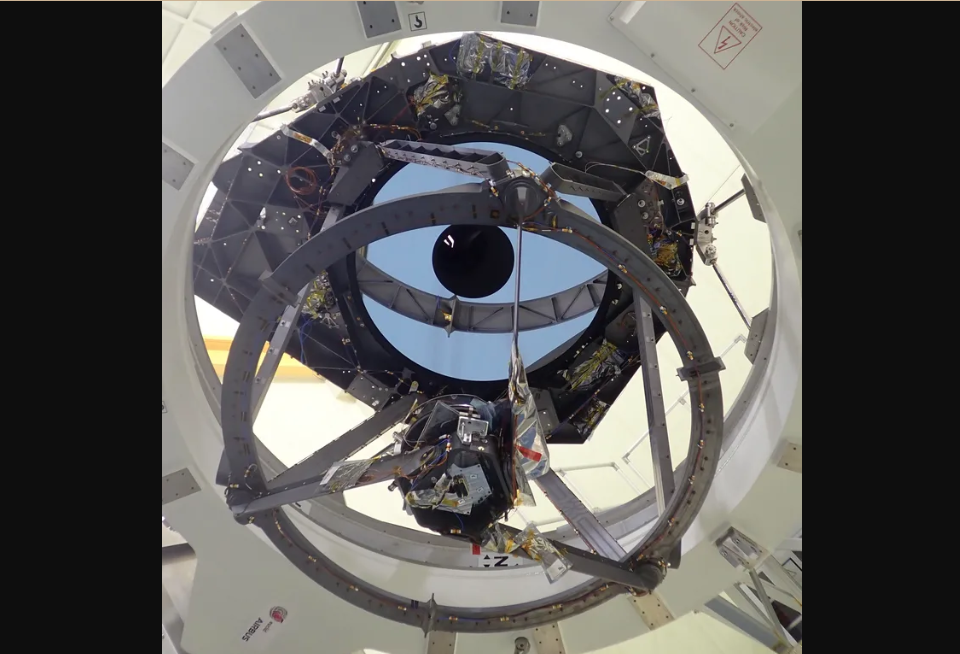The Space Telescope Studying Dark Matter And Energy Across The Universe
The space telescope studying dark matter and energy across the universe as the European Space Agency (ESA) successfully launched the Euclid mission. Carried into space by a SpaceX Falcon 9 rocket, the 2.2-ton spacecraft, equipped with a 1.2-meter telescope, is now en route to its designated orbit around the sun.
Author:Daniel JamesReviewer:Karan EmeryJul 06, 20236.5K Shares168.8K Views

The space telescope studying dark matter and energy across the universeas the European Space Agency (ESA) successfully launched the Euclid mission. Carried into space by a SpaceX Falcon 9 rocket, the 2.2-ton spacecraft, equipped with a 1.2-meter telescope, is now en route to its designated orbit around the sun.
Originally scheduled to launch using a Russian Soyuz rocket from Europe's spaceport in French Guiana, the mission encountered a setback due to the cessation of cooperation between ESA and Russia following Russia's invasion of Ukraine. As a result, the Euclid telescope was launched from Cape Canaveral Space Force Station in Florida. The liftoff took place at 12:11 AM ET on Saturday, July 1st.
The telescope is bound for an orbit known as L2, which is the second Lagrange point. This orbit, utilized by other space telescopes such as the James Webb Space Telescope, offers exceptional stability. Stability is crucial for the Euclid mission, which aims to gather highly precise observations of the universe.
After approximately four weeks, Euclid is expected to reach its destination at L2. Subsequently, it will undergo two months of preparations before commencing scientific observations around the beginning of October.
Euclid's primary objective is to conduct wide and deep surveys of the universe, employing image-stitching techniques to construct a comprehensive map. This ambitious endeavor aims to shed light on two perplexing phenomena: dark matter and dark energy. Dark matter, constituting roughly 27 percent of the cosmos, eludes direct detection as it does not interact with light.
Dark energy, accounting for approximately 68 percent of the universe, remains enigmatic, representing an unknown form of energy. In contrast, the observable matter, comprising atoms, molecules, and tangible objects, merely encompasses a mere 5 percent, referred to as ordinary or baryonic matter.
The existence of dark matter and dark energy is inferred from their impact on galactic movements and the expansive nature of the universe. Nonetheless, comprehending these elusive entities presents a formidable challenge due to their limited interaction with conventional methods of observation.
Thus, unraveling their mysteries necessitates scrutinizing the universe on a grand scale. Euclid's ambitious mission strives to gather evidence and insights that will contribute to our understanding of these intriguing cosmic constituents.
According to a statement by Giuseppe Racca, Euclid Project Manager at ESA in a press briefing:
“„If you want to do cosmology and observe the cosmos as a whole, you need to take a big survey. And Euclid is specially designed with a very wide angle telescope to cover most of the universe that can be observed in a very short time.- Giuseppe Racca, Euclid Project Manager at ESA
During its six-year mission, the Euclid telescope will conduct surveys encompassing an impressive 36 percent of the sky. This expansive coverage is made possible by the telescope's remarkably wide field of view. The field of view refers to the portion of the sky observable through the telescope, and in the case of Euclid, it spans 2.5 times the size of the moon.
To provide a basis for comparison, let's consider the Hubble Space Telescope. While Hubble excels in capturing detailed images of celestial objects such as galaxies and nebulae, its field of view is a mere 1/12th the size of the moon. Consequently, if Hubble were tasked with surveying an equivalent sky area to Euclid, it would require a staggering timeframe of approximately 1,000 years.
Euclid's significantly wider field of view enables it to efficiently scan and explore vast cosmic expanses, providing valuable insights into the mysteries of the universe within a more manageable time frame.
The limited coverage of just over a third of the sky by the Euclid mission is due to the obstruction caused by closer stars and interstellar dust within our own galaxy, preventing the observation of distant galaxies in other regions of the sky.
Euclid carries two essential instruments: the VISible instrument (VIS), designed to operate in the visible light wavelength, and the Near-Infrared Spectrometer and Photometer (NISP), which functions in the near-infrared range. This dual-wavelength capability enables researchers to observe galaxies that are redshifted. Redshift occurs when galaxies move away from us, causing the light they emit to shift toward the red end of the spectrum.
By combining observations from both the VIS and NISP instruments, Euclid can generate a three-dimensional map illustrating the distribution of visible matter in the universe. However, it is important to note that dark matter itself is not directly visible, which contributes to the challenge of studying it. Instead, the presence of dark matter can be inferred by examining the distribution and behavior of observable matter.
René Laureijs, Euclid Project Scientist, explained that:
“„Dark energy and dark matter reveal themselves by the very subtle changes they make to the appearance of objects in the visible universe.- René Laureijs, Euclid Project Scientis
Euclid will employ two primary methods, weak lensing, and galaxy clustering, to investigate dark energy and dark matter. By employing multiple approaches to examine the same phenomena, researchers aim to enhance the accuracy and reliability of their findings through cross-validation.
Weak lensing, one of the techniques utilized by Euclid, involves the study of gravitational lensing. This phenomenon occurs when the gravitational pull of massive objects, such as galaxies or galaxy clusters, distorts spacetime, functioning akin to a magnifying glass. As a result, the light emitted by distant objects located behind the foreground object is altered, providing valuable insights into the properties and distribution of dark matter and dark energy.
Additionally, Euclid will utilize galaxy clustering as another avenue for exploration. This method involves analyzing the spatial distribution patterns of galaxies to understand their clustering behavior, which in turn can yield crucial information about the underlying structure of the universe, including the influence of dark matter and dark energy.
By employing these complementary techniques, Euclid aims to strengthen the understanding of dark energy and dark matter, enabling researchers to corroborate and refine their findings through the convergence of results from different observational methods.
One of the key methods employed by Euclid is the measurement of gravitational lensing effects, which enables scientists to determine the mass of foreground objects. By quantifying the strength of the lensing effect, researchers can calculate the mass of the object in the foreground and compare it to the observed mass of visible matter within the galaxy. If a significant disparity exists between the calculated and observed masses, it suggests the presence of substantial amounts of dark matter within the foreground object.
The second method, galaxy clustering, pertains to the spatial distribution of galaxies in three dimensions throughout the universe. As the universe expands, galaxies move away from each other, resulting in a phenomenon known as redshift.
By comparing the measured distance to a galaxy with its observed redshift, scientists can utilize a phenomenon called baryon acoustic oscillations. This comparison provides insights into the rate at which the universe is expanding, which is directly connected to the influence of dark energy.
By combining these approaches, Euclid aims to leverage gravitational lensing measurements and galaxy clustering analyses to refine our understanding of dark matter and dark energy. The comparisons between calculated and observed masses and the examination of galaxy distributions provide valuable information for studying these elusive cosmic components.
The utilization of these methods in conjunction is expected to yield significant advancements in our understanding of dark matter and dark energy. Euclid's extensive data collection endeavors involve capturing approximately 1 million images from a staggering 12 billion objects throughout its mission.
Conclusion
This ambitious undertaking aims to propel us closer to the ability to detect and study these enigmatic phenomena while unraveling the intricate composition of the universe that surrounds us.
“It’s more than a space telescope,” Laureijs said, “it’s really a dark energy detector.”
Jump to

Daniel James
Author
Daniel James is a distinguished gerontologist, author, and professional coach known for his expertise in health and aging.
With degrees from Georgia Tech and UCLA, including a diploma in gerontology from the University of Boston, Daniel brings over 15 years of experience to his work.
His credentials also include a Professional Coaching Certification, enhancing his credibility in personal development and well-being.
In his free time, Daniel is an avid runner and tennis player, passionate about fitness, wellness, and staying active.
His commitment to improving lives through health education and coaching reflects his passion and dedication in both professional and personal endeavors.

Karan Emery
Reviewer
Karan Emery, an accomplished researcher and leader in health sciences, biotechnology, and pharmaceuticals, brings over two decades of experience to the table. Holding a Ph.D. in Pharmaceutical Sciences from Stanford University, Karan's credentials underscore her authority in the field.
With a track record of groundbreaking research and numerous peer-reviewed publications in prestigious journals, Karan's expertise is widely recognized in the scientific community.
Her writing style is characterized by its clarity and meticulous attention to detail, making complex scientific concepts accessible to a broad audience. Apart from her professional endeavors, Karan enjoys cooking, learning about different cultures and languages, watching documentaries, and visiting historical landmarks.
Committed to advancing knowledge and improving health outcomes, Karan Emery continues to make significant contributions to the fields of health, biotechnology, and pharmaceuticals.
Latest Articles
Popular Articles
